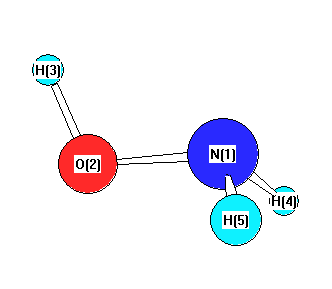Vibrational Frequencies calculated at B2PLYP/daug-cc-pVTZ
| Mode Number |
Symmetry |
Frequency
(cm-1) |
Scaled Frequency
(cm-1) |
IR Intensities
(km mol-1) |
Raman Act
(Å4/u) |
Dep P |
Dep U |
|---|
| 1 |
A' |
3827 |
3827 |
45.11 |
64.67 |
0.18 |
0.30 |
| 2 |
A' |
3468 |
3468 |
1.53 |
124.75 |
0.07 |
0.13 |
| 3 |
A' |
1670 |
1670 |
15.00 |
4.07 |
0.53 |
0.69 |
| 4 |
A' |
1397 |
1397 |
25.71 |
3.18 |
0.12 |
0.22 |
| 5 |
A' |
1150 |
1150 |
123.19 |
1.86 |
0.08 |
0.15 |
| 6 |
A' |
924 |
924 |
12.79 |
12.03 |
0.23 |
0.37 |
| 7 |
A" |
3552 |
3552 |
3.91 |
50.75 |
0.75 |
0.86 |
| 8 |
A" |
1331 |
1331 |
0.14 |
1.89 |
0.75 |
0.86 |
| 9 |
A" |
412 |
412 |
165.43 |
0.15 |
0.75 |
0.86 |
Unscaled Zero Point Vibrational Energy (zpe) 8865.6 cm
-1
Scaled (by 1) Zero Point Vibrational Energy (zpe) 8865.6 cm
-1
See section
III.C.1 List or set vibrational scaling factors
to change the scale factors used here.
See section
III.C.2
Calculate a vibrational scaling factor for a given set of molecules
to determine the least squares best scaling factor.
Charges, Dipole, Quadrupole and Polarizability
Charges from optimized geometry at B2PLYP/daug-cc-pVTZ
Charges (e)
| Number |
Element |
Mulliken |
CHELPG |
AIM |
ESP |
| 1 |
N |
-0.160 |
|
|
|
| 2 |
O |
-0.746 |
|
|
|
| 3 |
H |
0.372 |
|
|
|
| 4 |
H |
0.267 |
|
|
|
| 5 |
H |
0.267 |
|
|
|
Electric dipole moments
Electric dipole components in Debye
(What's a Debye? See section
VII.A.3)
| |
x |
y |
z |
Total |
| |
0.125 |
0.592 |
0.000 |
0.605 |
| CHELPG |
|
|
|
|
| AIM |
|
|
|
|
| ESP |
|
|
|
|
Electric Quadrupole moment
Quadrupole components in D Å
| Primitive |
|---|
| | x | y | z |
|---|
| x |
-11.538 |
3.793 |
-0.001 |
| y |
3.793 |
-13.017 |
-0.004 |
| z |
-0.001 |
-0.004 |
-11.902 |
|
| Traceless |
|---|
| | x | y | z |
|---|
| x |
0.922 |
3.793 |
-0.001 |
| y |
3.793 |
-1.297 |
-0.004 |
| z |
-0.001 |
-0.004 |
0.375 |
|
| Polar |
|---|
| 3z2-r2 | 0.750 |
|---|
| x2-y2 | 1.479 |
|---|
| xy | 3.793 |
|---|
| xz | -0.001 |
|---|
| yz | -0.004 |
|---|
|
Polarizabilities
Components of the polarizability tensor.
Units are
Å
3 (Angstrom cubed)
Change units.
| |
x |
y |
z |
| x |
2.703 |
0.240 |
0.000 |
| y |
0.240 |
3.280 |
0.000 |
| z |
0.000 |
0.000 |
2.542 |
<r2> (average value of r
2) Å
2
| <r2> |
20.967 |
| (<r2>)1/2 |
4.579 |
